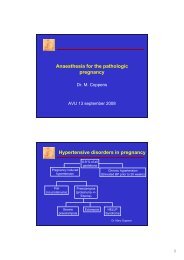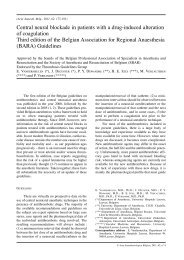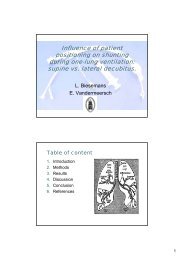Combined spinal epidural analgesia for labor and delivery
Combined spinal epidural analgesia for labor and delivery
Combined spinal epidural analgesia for labor and delivery
You also want an ePaper? Increase the reach of your titles
YUMPU automatically turns print PDFs into web optimized ePapers that Google loves.
COMBINED SPINAL EPIDURAL ANALGESIA FOR LABOR AND DELIVERY 117<br />
100 µg. Duration of intrathecal <strong>analgesia</strong> was consistently<br />
prolonged (58, 64).<br />
Un<strong>for</strong>tunately, epinephrine also induces an<br />
increased incidence of maternal motor deficit, especially<br />
when administered <strong>epidural</strong>ly or intrathecally<br />
(31, 61). Vercauteren, however, reported that minute<br />
doses (2.25 µg) of <strong>spinal</strong> epinephrine were not associated<br />
with more motor block (166). This was confirmed<br />
by Gurbet <strong>and</strong> co-workers (64). Epidural<br />
epinephrine might also prolong labour duration<br />
through b-agonist effects, especially when higher<br />
doses are infused in the <strong>epidural</strong> space (46, 112,<br />
115). Furthermore, adding epinephrine to pharmacist<br />
pre-prepared solutions complicates storage <strong>and</strong><br />
significantly increases the price of h<strong>and</strong>ling <strong>and</strong><br />
preparation. Thus, this author has ab<strong>and</strong>oned the<br />
addition of epinephrine to the local anaesthetic<br />
solution used <strong>for</strong> <strong>spinal</strong> <strong>and</strong> <strong>epidural</strong> administration.<br />
Neostigmine<br />
NELSON et al. investigated the analgesic potential<br />
<strong>and</strong> side effect profile of 5, 10, 20 µg intrathecal<br />
neostigmine alone (101). From this first phase<br />
study, these investigators chose 10 µg as the optimal<br />
dose to be added to intrathecal sufentanil <strong>and</strong> determined<br />
the ED 50 of <strong>spinal</strong> sufentanil with <strong>and</strong> without<br />
neostigmine. Neostigmine successfully reduced<br />
the ED 50 of <strong>spinal</strong> sufentanil. In a further step, they<br />
compared twice the ED 50 of <strong>spinal</strong> sufentanil with<br />
neostigmine to twice the ED 50 of plain <strong>spinal</strong> sufentanil.<br />
A synergistic effect on the duration of neostigmine-induced<br />
<strong>analgesia</strong> was observed. D’ANGELO et<br />
al., however, reported no increase in analgesic duration<br />
with neostigmine as a part of a multi-drug combination<br />
(local anaesthetic, opioid, clonidine <strong>and</strong><br />
neostigmine) (42). Furthermore, several authors<br />
reported a very high incidence of severe nausea <strong>and</strong><br />
vomiting (116).<br />
Other drugs : magnesium <strong>and</strong> adenosine<br />
Both adenosine <strong>and</strong> magnesium have been<br />
added to intrathecal opioids to relieve labour<br />
pain (18, 133). No significant advantages of adding<br />
adenosine to the analgesic mixture were observed.<br />
Magnesium prolonged intrathecal fentanyl <strong>analgesia</strong>.<br />
MAINTENANCE OF EPIDURAL ANALGESIA FOLLOWING THE<br />
INITIAL SPINAL DOSE<br />
OKUTOMI et al. studied the optimal moment to<br />
initiate a continuous <strong>epidural</strong> infusion following the<br />
initial <strong>spinal</strong> dose (114). These authors suggested to<br />
start the infusion early, within 30 minutes of the<br />
<strong>spinal</strong> dose, to avoid breakthrough pain. MISSANT et<br />
al. studied patient-controlled <strong>epidural</strong> <strong>analgesia</strong><br />
(PCEA) with or without a continuous <strong>epidural</strong> infusion.<br />
They concluded that a background infusion<br />
resulted in less breakthrough pain, less anesthetist<br />
interventions <strong>and</strong> less local anesthetic consumption<br />
(97). OKUTOMI et al. recently confirmed these<br />
findings with a slightly higher background infusion<br />
(113).<br />
GENERAL CONCLUSIONS<br />
CSE <strong>analgesia</strong> is a very popular technique <strong>for</strong><br />
<strong>labor</strong> pain relief. A recent Cochrane review suggests<br />
that CSE produces much faster <strong>analgesia</strong> then<br />
conventional <strong>epidural</strong> <strong>analgesia</strong>. Although various<br />
authors limit the use of the technique to specific<br />
indications, a wide variety of indications has been<br />
described by different authors. As a result, almost<br />
all patients fall in one of these categories. CSE <strong>analgesia</strong><br />
provides rapid, highly effective <strong>analgesia</strong> with<br />
Table 3<br />
Suggested drug combinations <strong>for</strong> intrathecal use to initiate CSE labour <strong>analgesia</strong>. Dose may vary<br />
according to the stage of labour <strong>and</strong> intensity of labour pain<br />
Local anesthetic (mg) Opioid (µg) Volume (mL)<br />
Suggestion 1 Bupivacaine 2.5-3.5 mg Sufentanil 1.5-2.5 µg 2-3 mL<br />
Suggestion 2 Bupivacaine 2.5-3.5 mg Fentanyl 10-15 µg 2-3 mL<br />
Suggestion 3 Levobupivacaine 3.5-4.5 mg Sufentanil 1.5-2.5 µg 2-3 mL<br />
Suggestion 4 Levobupivacaine 3.5-4.5 mg Fentanyl 10-15 µg 2-3 mL<br />
Suggestion 5 Ropivacaine 3.5-4.5 mg Sufentanil 1.5-2.5 µg 2-3 mL<br />
Suggestion 6 Ropivacaine 3.5-4.5 mg Fentanyl 10-15 µg 2-3 mL<br />
These are just suggestions based on literature evidence <strong>and</strong> personal experience from the author.<br />
© Acta Anæsthesiologica Belgica, 2009, 60, n° 2
















